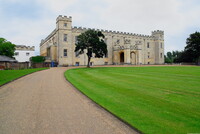Syon House
Adam, Robert

Download1A2-E-L-SH-A3_cp.jpg (448.0Kb)
Date
2013-01-25Description
Described by Sir John Betjeman as 'the Grand Architectural Walk', Syon House and its 200 acre park is the London home of the Duke of Northumberland, whose family have lived here for over 400 years. Originally the site of a medieval abbey, Syon was named after Mount Zion in the Holy Land. At Syon House, London, between 1760 and 1769, Adam took a quadrangular Tudor nunnery with a later Jacobean long gallery, which had been somewhat adapted for greater aristocratic comfort, and transformed it into what Horace Walpole was to describe as ‘another Mount Palatine’. He created a series of rooms of varied and unusual shapes, partially derived from Roman Baths; these he ornamented with lively decoration, also reflecting Classical influences, ranging from apses screened by columns to statuary, grotesques and trophy panels. Responding to the demands of fashionable society, these were spaces intended for various functions that not only were appropriate for those functions but delighted the eye by their variation and ornamentation. This would have been carried even further had he been allowed to fill Syon’s interior courtyard with a great circular saloon, as he had intended (the cost was prohibitive).; Described by Sir John Betjeman as 'the Grand Architectural Walk', Syon House and its 200 acre park is the London home of the Duke of Northumberland, whose family have lived here for over 400 years. Originally the site of a medieval abbey, Syon was named after Mount Zion in the Holy Land. At Syon House, London, between 1760 and 1769, Adam took a quadrangular Tudor nunnery with a later Jacobean long gallery, which had been somewhat adapted for greater aristocratic comfort, and transformed it into what Horace Walpole was to describe as ‘another Mount Palatine’. He created a series of rooms of varied and unusual shapes, partially derived from Roman Baths; these he ornamented with lively decoration, also reflecting Classical influences, ranging from apses screened by columns to statuary, grotesques and trophy panels. Responding to the demands of fashionable society, these were spaces intended for various functions that not only were appropriate for those functions but delighted the eye by their variation and ornamentation. This would have been carried even further had he been allowed to fill Syon’s interior courtyard with a great circular saloon, as he had intended (the cost was prohibitive). Source: Grove Art Online; http://www.oxfordartonline.com/ (accessed 6/15/2009)
Type of Work
country houseSubject
architectural exteriors, decorative arts, historical, rulers and leaders, Neoclassical, Renaissance, Tudor
Rights
Rights Statement
Licensed for educational and research use by the MIT community only